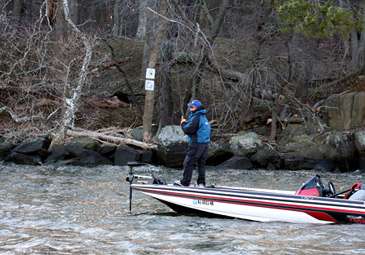
Last week's horrible weather during practice made the first Bassmaster Northern Open presented by Oakley on the Chesapeake Bay anyone's tournament. To a man the anglers said they were clueless as they made final modifications to their tackle. Despite that, however, three anglers were able to rise to the top of the field.
Here's how they did it:
Dave Mansue
(1st Place — 46 pounds, 6 ounces)
Dave Mansue of Robbinsville, N.J., won his first BASS professional tournament by making the best of every bite he got.
"My practice was horrible. I finally managed to find a few deep rockpiles up in the Susquehanna River on the last day before the tournament started. I was marking fish around them so I knew they were there. The problem was getting a bait down to them because of the strong current.
"I ultimately settled on a 3/4-ounce football jig. It would drop through the current and get into the rocks — most of my good spots were between 6 and 12 feet deep — where the bass were holding."
According to Mansue, the bite was current dependent. Water being released from an upstream dam combined with the tide and the wind to make an iffy and sporadic bite productive.
"The first two days they would turn on with the current for maybe 15 minutes and then go dead. On the first day, I only had five bites. Fortunately, I caught them all. I had another six or seven bites on the second day and managed to boat another five."
Saturday was another story, however. Mansue's early morning bite disappeared with the current. After running around trying to find something else, he noticed the current picked up. He immediately returned to his original area and was able to put three solid keepers in his livewell, again boating almost every bass that tried to eat his jig.
"I'd have to say the lesson here is to stick with the pattern that's working for you whenever possible. On Saturday, I immediately went back to basics when the water started moving.
"I was willing to throw whatever it took to catch them. It's frustrating to hang constantly, break-off and have to re-tie. And it's no fun to run from boat to boat on Friday night trying to beg and borrow any heavy football head jig you can. But if that's what it takes to win a tournament, that's what you have to do."
Tackle: A 7-foot Shimano Crucial rod (heavy action) and a Shimano Chronarch reel (6:1 gear ratio) spooled with 15-pound-test Berkley Trilene 100% Fluorocarbon line. (The rod and reel are old and no longer in production.) He used a green pumpkin, Zoom Ultra Vibe Chunk as a trailer on his jigs.
Curtis Richardson
(2nd Place — 41 pounds, 6 ounces)
Canadian angler Curtis Richardson targeted smallmouths as he marched to a second place finish.
"My largemouth bite was awful during practice. I know in Canada when that happens oftentimes the smallmouths turn on, especially when the wind and water are cold. I thought the same pattern might hold here, so I ran up into the Susquehanna River to look around.
"I found some bridge pilings and underwater points in 9-15 feet of water with a series of ditches around them. The bass were in the ditches waiting for bait to be washed past them."
Richardson fished with a drop shop rig. He tied a Slammer — a goby-style bait made by Strike Zone Tournament Baits — about 12 inches above a 3/8-ounce lead weight. He lowered his rig to the bottom and let the strong current wash it naturally over the waiting bass.
"It was a good technique, but I lost at least nine keepers doing it. I was having trouble keeping the slack out of my line. That prevented me from getting a good hookset. Normally, you don't lose many fish with a drop shot. It's a pretty reliable rig.
"It was a price I was willing to pay, however. Sometimes you have to look at the final result. Sure, it was frustrating to lose fish. But I was also putting good sized ones in the boat."
Tackle: A 7-foot spinning rod (medium action) and an old spinning reel spooled with 8-pound-test Gamma Edge Fluorocarbon line. He used a No. 2 drop shot hook to arm his Slammer.
Frank Scalish
(3rd Place — 39 pounds, 10 ounces)
Cleveland, Ohio's Frank Scalish wasted two days of practice before he decided to rely on his instincts.
"When I first came here, they told me the grass was the key. Well, after two days of worthless practice I decided to do what I do best, fish rivers. I found some bass in the Susquehanna River holding on isolated rockpiles scattered on giant flats in 9-17 feet of water.
"I targeted the deeper bass with a 5/8-ounce Jewel Football Jig — black and blue with a black and purple twin-tail grub as a trailer. I just dragged it along. The shallower rocks produced better with a 5/8-ounce, black and blue Booyah Pro Boo Bug with a black and blue flake Yum Wooly Hawg Craw as a trailer. I let it drop to the bottom and then snapped it up real fast.
"The most important thing that I did was to stop listening to what other anglers were saying. I fished the way I knew how to fish and it paid off for me in the end."
Tackle: For the Booyah jig he used a 7-foot, 6-inch Powell rod (heavy action) and an Abu Garcia Revo STX reel (6.4:1 gear ratio) spooled with 20-pound-test Silver Thread Fluorocarbon line.
For the Jewel jig he switched to a 7-foot Powell rod (medium-heavy action) and the same model Revo reel spooled with 17-pound-test Silver Thread Fluorocarbon line.
